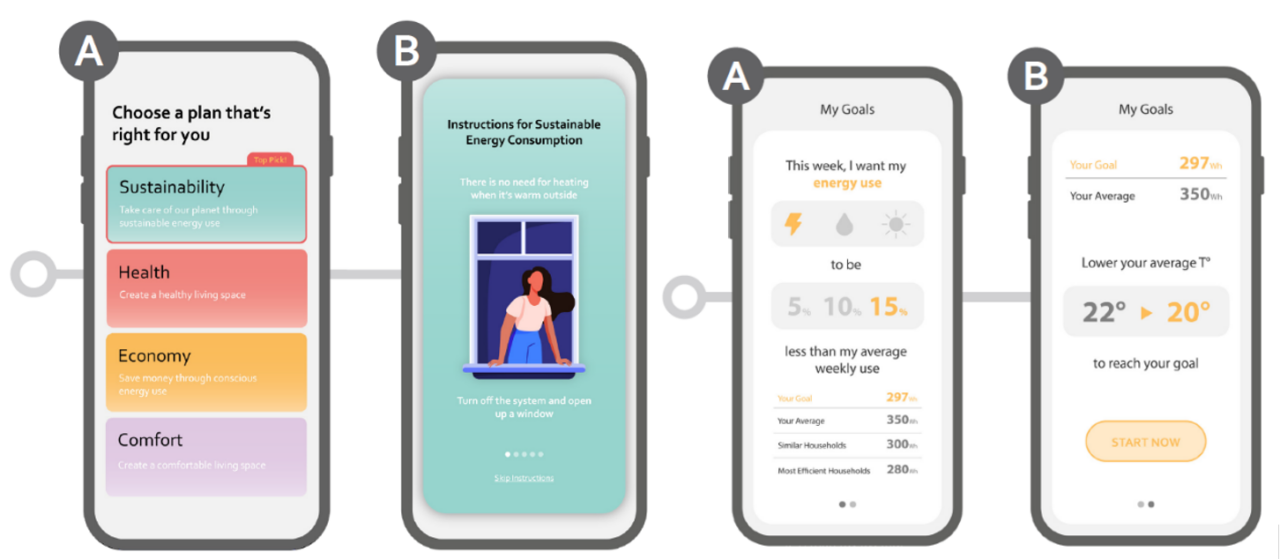Co-creation workshops – evaluating and designing the project nudges
In the first half of October 2021 a series of co-creation workshops were organised in our pilot countries to evaluate the respective nudges of each pilot in terms of user acceptance, comprehensibility and ease-of-use. +/- 8 people (who participate in the pilot) participated per workshop and were presented with prototypes of the applications, that would then be adapted for full functionality.
IMEC organized a first co-creation workshop/study group in Ghent, Belgium on July 15 to evaluate the generic nudge designs. The workshop allowed gaining insight into end users’ current energy practices and the preliminary evaluation of nudging designs.
Thereafter, three more workshops were organized for respectively the Greek, Portuguese, and Croatian pilots to evaluate the prospective nudges that will be implemented in the energy monitoring applications. The workshops resulted in valuable feedback from the users that will ultimately assist in the design and implementation of the nudges within the domX smartphone application.
How are the workshops organised and what does it bring to NUDGE researchers?
Some research questions that NUDGE partners wanted to touch upon included:
- How do people monitor and control their energy consumption?
- Are people aware of their most-used appliances?
- Concerns, frustrations & delights regarding current practices
- How do needs and requirements vary for different households and energy equipment?
- What are the barriers that prevent consumers from adopting energy conservation behaviour?
- What are the triggers that motivate consumers to adopt energy conservation behaviour?
IMEC together with the respective pilot sites (domX, INEGI, and ZEZ) evaluated the nudges in terms of user acceptance, usefulness, and positive/negative emotions, to understand what information motivates people the most to save energy, how goal setting or social comparison can impact energy consumption, etc. Showed some apps screenshots, participants gave their feedback on the messages and approaches and how it would make them (re)act.
For instance, empathy prompts could be:
- “You have consumed …% more energy than you produced yesterday. This amount of energy is enough for 1 energy deprived family to cook a meal.”
Whereas moral norm prompts could be:
- “By only using the amount of energy you need you contribute to a healthy environment and community.”
This work helps our researchers to determine the focus of the interventions (starting from 2022) and the pilot sites to tap into the needs and current behaviour of households by optimizing their nudging strategies.
Examples of findings from the discussions:
- People won’t commit to goals on a weekly basis. One suggestion was to organize an ‘energy saving month’ (cf. ‘Tournee Minerale’ and ‘Maai mei niet’ in Belgium), which motivates people to perform sustainable behaviour during a fixed timeframe. This commitment period can be repeated each year.
- From a gamification perspective, it could be fun to compete against other neighbourhoods or even countries. However, some participants argued that group goals would be short-lived if they are only rooted in a gamification rationale rather than motivated by social pressure.
The key findings and takeaways of these workshops are:
- Thermal comfort within households might be a breaking point with some people not willing to give up warmth at the expense of saving energy.
- The decision of people whether or not to be committed to save energy is heavily determined by one’s interests and attitudinal factors, such as environmental concern, bill consciousness, thermal comfort, quantified self, …
- The content of the application and its nudges should be tailored to the motivation of the user, such as framing goals in euros/attainment of the sustainable development goals/Whs/…
- Need for well-explained concepts, which are linked to system settings: sustainability, eco-mode, efficient heating, …
- Energy consumption and conservation is subject to socially desirable behaviour. There is a fine line between what is acceptable from nudging and what is employing guilt (e.g., colour coding, extreme default settings, ‘comfort modus’).
For a reminder on what nudges are and the different categories of nudges, see here.


